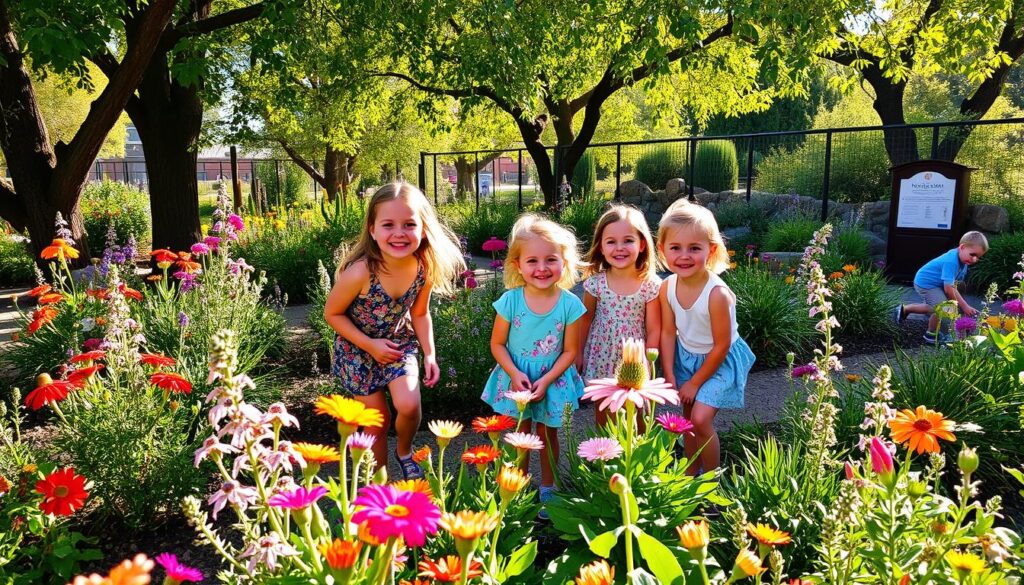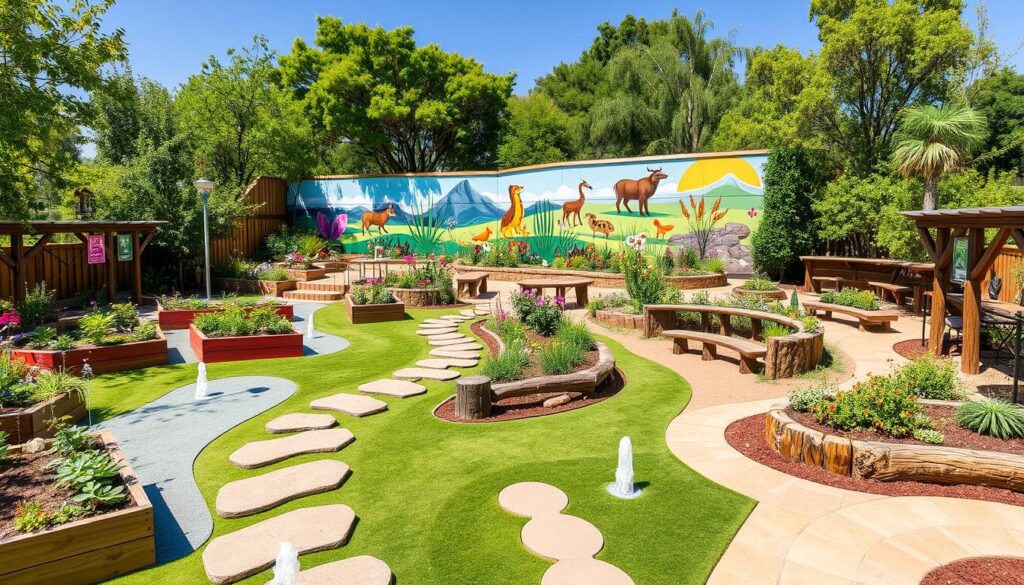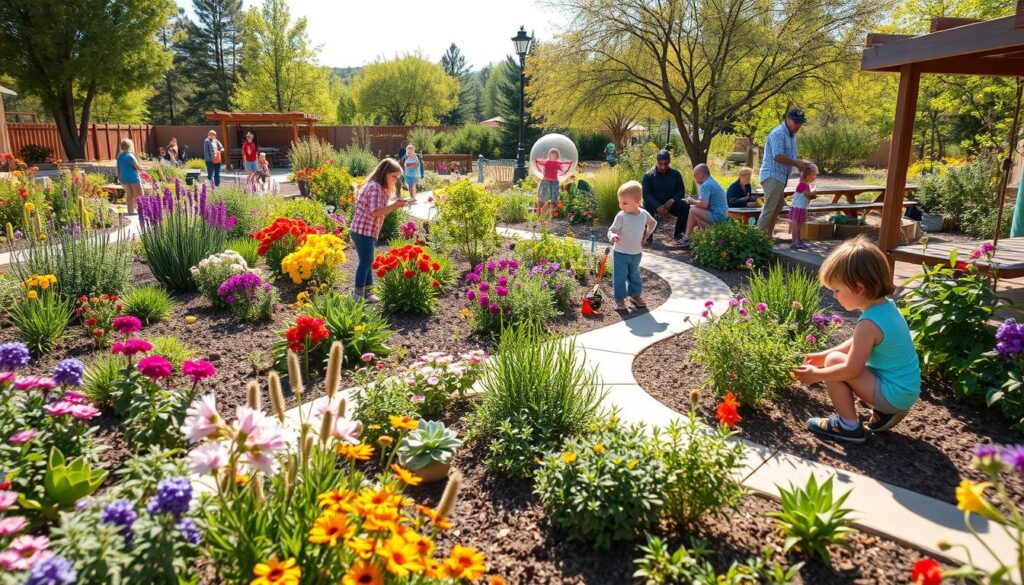
Prescott families are finding a new way to connect with nature. They’re discovering children’s discovery landscape gardens all over the city. These gardens are special outdoor learning spaces that mix Prescott landscape design with nature exploration.
In these gardens, kids can touch, smell, and explore Arizona’s native plants. They climb, dig, and play, learning about the environment. These spaces turn nature into a classroom, sparking curiosity and wonder in young minds.
We’ll explore the benefits and design of children’s discovery gardens. We’ll see how they promote physical activity and learning. We’ll also talk about using local plants and animals, making these gardens a true reflection of Prescott’s ecosystem.
Key Takeaways
- Discovery gardens offers outdoor learning opportunities for Prescott families
- These spaces blend nature exploration with family-friendly activities
- Gardens promote physical activity and cognitive development in children
- Prescott landscape design incorporates local flora and fauna
- Discovery gardens serve as living classrooms, inspiring curiosity in kids

The Importance of Children’s Discovery Landscape Gardens
Children’s discovery landscape gardens are key for growing kids. They offer a chance for kids to learn and explore nature. In Prescott, these gardens are green spaces where kids can connect with nature.
Fostering Outdoor Learning and Exploration
Discovery gardens are hands-on learning spaces. Kids learn about plants, insects, and ecosystems by doing. These gardens spark curiosity and make kids want to learn more about the world.
Promoting Physical Activity and Cognitive Development
Landscape gardens are great for kids to be active. Climbing, digging, and exploring help improve motor skills. Problem-solving in the garden boosts cognitive abilities, helping kids grow well-rounded.
Connecting Children with Nature in Urban Settings
In cities, discovery gardens are green oases. They offer a natural escape from city life. Regular visits help kids develop an early love for nature and care for the environment.
- Encourages outdoor play and exploration
- Supports physical and mental development
- Provides access to nature in urban environments
- Promotes environmental education
By adding these gardens to urban plans, we ensure all kids can enjoy nature-based learning and outdoor fun. Unlock new knowledge by reading this remarkable piece.
Key Elements of an Educational Landscape for Children
Educational landscapes for kids are special places for learning and growing. They mix nature with design to make fun spaces. These spaces help young minds and bodies grow.
Sensory gardens are key in these landscapes. They have plants with different textures, colors, and smells. Kids can explore with all their senses. There are also wind chimes, water features, and paths to make it even more fun.
Themed play areas take kids to new worlds. They can be pirate ships, fairy forests, or dinosaur sites. These places spark creativity and help kids learn through play.
Outdoor classrooms teach outside the usual classroom. They have seats, writing surfaces, and natural materials. Teachers can use the outdoors to make science and art real.
Nature-inspired playgrounds fit right into the landscape. They use logs, boulders, and rope for climbing and swings. These playgrounds help kids be brave and grow strong in a natural setting.
- Butterfly gardens to teach about life cycles
- Vegetable patches for hands-on gardening lessons
- Weather stations for monitoring local climate
- Bug hotels to observe insect habitats
These elements make educational landscapes rich and full of life. They support kids’ learning, growth, and connection with nature.
Incorporating Local Flora and Fauna in Prescott Gardens
Prescott gardens are great for showing off Arizona native plants and making spaces friendly for wildlife. Families can create amazing outdoor areas. These areas teach kids about local ecosystems and help save water.
Native Plant Species for Year-Round Interest
Arizona native plants make Prescott gardens beautiful and strong. Here are some good choices:
- Penstemon: Vibrant flowers attract hummingbirds
- Agave: Striking succulents with low water needs
- Desert Marigold: Cheerful yellow blooms throughout summer
- Yucca: Dramatic spiky leaves and tall flower stalks
Creating Habitats for Local Wildlife
Make your garden a home for native animals. Add:
- Bird baths and feeders
- Butterfly-friendly nectar plants
- Rock piles for lizards and insects
- Native grasses for small mammals
These features make your garden a place for kids to learn. They can see and learn about local wildlife.
Sustainable Gardening Practices for Desert Climates
Save water in your Prescott garden:
- Install drip irrigation systems
- Use mulch to retain soil moisture
- Group plants with similar water needs
- Harvest rainwater for garden use
These steps teach kids about caring for resources. They help keep your garden alive in Prescott’s special climate.
Interactive Features for Hands-On Learning
Children’s discovery gardens are full of interactive features. They spark curiosity and encourage kids to explore. These elements offer endless chances for hands-on learning and outdoor STEM activities.

Nature-based play structures are key in these gardens. Climbing walls, tree houses, and balance beams from logs help kids develop their motor skills. They also connect with nature in a fun way.
Environmental education thrives in these gardens. Interactive stations teach kids about the environment. Weather monitoring stations let them track changes in weather. Composting areas teach about decomposition and soil health. Solar-powered water features show how renewable energy works.
- Sensory gardens with plants of various textures, scents, and colors
- Butterfly gardens to observe life cycles
- Herb spirals for lessons in plant identification and uses
- Sundials for understanding Earth’s rotation and time
Outdoor STEM activities make science fun in these gardens. Magnifying glasses and bug viewers help kids observe insects and plants closely. Simple machines like pulleys and levers teach basic physics. Water play areas with dams, channels, and pumps introduce fluid dynamics.
By adding these interactive features, children’s discovery gardens become living classrooms. They foster a love for learning and the natural world.
Safety Considerations in Children’s Discovery Landscape Gardens
Creating a safe space for kids to explore and learn is key in discovery gardens. A well-designed garden mixes fun with safety. This way, kids can have fun outside without risks.
Age-Appropriate Design and Equipment
Choosing the right equipment for kids is important. Toddlers need low structures and soft surfaces. Older kids can handle more, like climbing walls or balance beams. Always check for sharp edges or dangers.
Non-Toxic Plant Selection
Choosing safe plants is crucial in discovery gardens. Stay away from plants with thorns, toxic berries, or sap. Go for sturdy, non-toxic plants that can handle curious kids. Safe options include:
- Sunflowers
- Marigolds
- Snapdragons
- Lamb’s ear
Proper Maintenance and Supervision Guidelines
Regular garden care keeps it safe and fun. Check equipment weekly and trim plants to prevent overgrowth. Remove any debris. Set clear rules for adults watching kids in the garden. This includes designated areas for different ages and rules for using equipment.
By focusing on these safety points, you can make a discovery garden that’s both fun and safe for kids.
Community Involvement and Educational Programs
Children’s discovery landscape gardens are all about community. In Prescott, these gardens bring families together. They teach kids to love nature and learn through hands-on experiences.

Community gardens are like outdoor classrooms. Kids learn about plants, composting, and how to care for the environment. They work together, learning teamwork and responsibility.
Family activities in these gardens make memories that last. Parents and kids plant seeds and harvest veggies together. They feel proud and connected to the community’s green spaces.
- Seasonal planting days
- Nature scavenger hunts
- Garden-to-table cooking classes
Outdoor workshops offer many learning chances. Garden experts teach about desert plants, and naturalists lead bird-watching. There’s something for everyone in the family.
These educational landscapes are lively learning centers. They grow plants and curious minds in Prescott’s kids.
Future Trends in Children’s Discovery Landscape Gardens
Children’s discovery gardens in Prescott are changing to meet new needs. They now have spaces that spark curiosity and engage all senses. These gardens can change to fit different ages and activities.
Technology is becoming a big part of outdoor learning. You’ll find interactive displays, augmented reality, and digital tools to help kids learn about plants. These tech tools add to hands-on activities, making learning fun and diverse.
Sustainable landscaping is key in these gardens. Designers use water-wise plants and systems to save water. They also add solar features. These choices teach kids about saving the environment and using renewable energy.
In the future, these gardens will be more welcoming to everyone. You’ll see areas for kids with different abilities and signs in many languages. These spaces will keep growing, helping kids love nature and learn for life.
Yavapai Landscaping Prescott offers free quotations for landscaping and tree services in Prescott and its nearby localities. These include tree removal, trimming, stump grinding, land clearance, storm cleaning, and emergency tree service.
